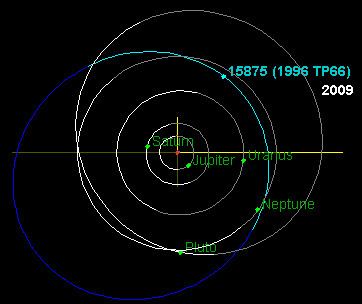Discovery date 11 October 1996 Alternative names none Observation arc 4394 days (12.03 yr) Inclination 5.6877° Orbits Sun | MPC designation (15875) 1996 TP66 Minor planet category TNO (plutino) Discovered 11 October 1996 Argument of perihelion 75.552° Discovery site Mauna Kea Observatories | |
 | ||
Discovered by C. Trujillo, D. C. Jewitt, and J. X. Luu Discoverers Jane Luu, Chad Trujillo, David C. Jewitt Similar (19308) 1996 TO66, (84922) 2003 VS2, (119951) 2002 KX14, (47171) 1999 TC36, S/2000 (1998 WW31) 1 | ||
(15875) 1996 TP66, also written as (15875) 1996 TP66, is a resonant trans-Neptunian object in 2:3 resonance with Neptune, like Pluto (plutino). It was discovered on 11 October 1996 by Chad Trujillo, David C. Jewitt, and Jane X. Luu at the Mauna Kea Observatory, Hawaii.
Contents
Inside the orbit of Neptune
This plutino is currently 27 AU from the Sun, and came to perihelion (q=26.3 AU) in 2000. This means that this small plutino is currently well inside the orbit of the planet Neptune. Like Pluto, this plutino spends part of its orbit closer to the Sun than Neptune. Like all resonant trans-Neptunian objects its orbit is dominated by Neptune. Simulations by the Deep Ecliptic Survey (DES) show that over the next 10 million years 1996 TP66 can acquire a perihelion distance (qmin) as small as 25.9 AU.
Probable dwarf planet Huya and plutino (120216) 2004 EW95 are also currently inside the orbit of Neptune.
Calculations by the Minor Planet Center in 1997 showed that the eccentric orbit comes within 6.9 AU of Uranus and stays more than 22.6 AU from Neptune over a 14,000-year period centered on the present.
Physical properties
The size of 1996 TP66 was estimated by the Herschel Space Telescope to be 7005154000000000000♠154.0+28.8
−33.7 km. The object has a very red surface in the visible and a flat featureless infrared spectrum.
